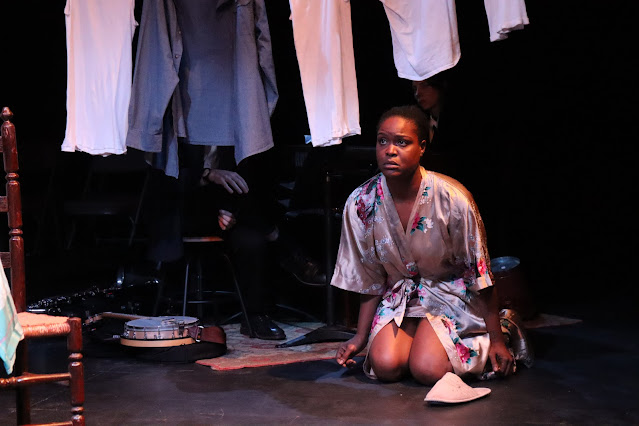Review: There's More to "Mahogany Brown and the Case of the Disappearing Kid" Than Meets the (Private) Eye
Mahogany Brown and the Case of the Disappearing Kid
Written by Gina Femia
Directed by Janelle Zapata Castellano
Presented by Step1 Theatre Project at The Tank
312 W 36 St., Manhattan, NYC
July 8-11, 2019
 |
| Alisha Espinosa and Lara Fox. Photo from step1theatreproject on Instagram |
Perhaps because of the light, Jones's make-up at first glance looked as if it had a bluish tinge, which, along with his invocation of zombie eyes, put one in mind of George A. Romero's Dawn of the Dead and its own overwhelming masses of disconnected humanity. However, with the introduction of Mahogany Brown, similarly dressed and made-up in black and white, it becomes clear that the reference point is the world of old gumshoe films that also inspires Brown's way of speaking and of standing with her arm outstretched and fingers together as if holding a cigarette, whether she has one or not (there is also a hint, perhaps, because of the actors' gloves, of classic black-and-white animation). Brown tells us that she specializes in disappearances, though she denies what Jones has heard about her also specializing in the supernatural. She also, significantly, hypothesizes that her clients are "really looking for" something more than the particular lost object, for instance, which they task her with finding. How far does her assertion apply to Jones's case? The clues are small at first, and in a testament to the quality of acting and directing, it is hard to be sure at first that they are clues, that there are much deeper layers to the situation, and what begins as an entertainingly comedic, self-aware pushing of genre tropes close to absurdist territory takes some unexpected and affecting turns as both the characters and the audience search for answers.
The theme of looking (in addition to the threads mentioned above, it takes only a moment of not-looking for Jones's son to disappear, and there are theories of creatures one can only glimpse in the corner of one's eye, as in the episode "Listen" of Doctor Who, a show that the play name-checks) is closely tied to a theme of alienation that manifests through multiple channels. There is of course the alienation of the modern urban individual, reflected in all those city-dwellers with their eyes open but "shut off," shutting themselves off from one another. There is also the more Brechtian alienation created by the look of the play, especially by Laura Mae Baker's make-up and costuming. The appearance of a black and white movie come to life lends everything an edge of unreality that is only enhanced by elements such as the few pops of color in the missing boy's red hat and his teacher Sunshine's (Lara Fox) hair and lemonade, as well as some exaggeratedly artificial scenes between Jones and Sunshine and the representation of his missing son by a simple flat wooden puppet (voiced and operated by Weekley). Finally, there is, we come to learn, an alienation from the self, one tied to storytelling as a means of dealing with the world and particularly with its traumas (something that narrative art, from this play to the media it evokes, participates in as well).
Rodney and Espinosa are excellent leads, and Espinosa is equally outstanding whether playing broad comedy or heartfelt pathos, or hinting at the one through cracks in the other. Weekley's child takes on different tones in different appearances, but his love of asking questions remains consistent. Unfortunately, Mahogany Brown contents, sometimes the answer is that there is no answer. It's lucky, then, that the answer to the question of whether to see Mahogany Brown and the Case of the Disappearing Kid is so clearly in the affirmative. Case closed.
-John R. Ziegler and Leah Richards



Comments
Post a Comment